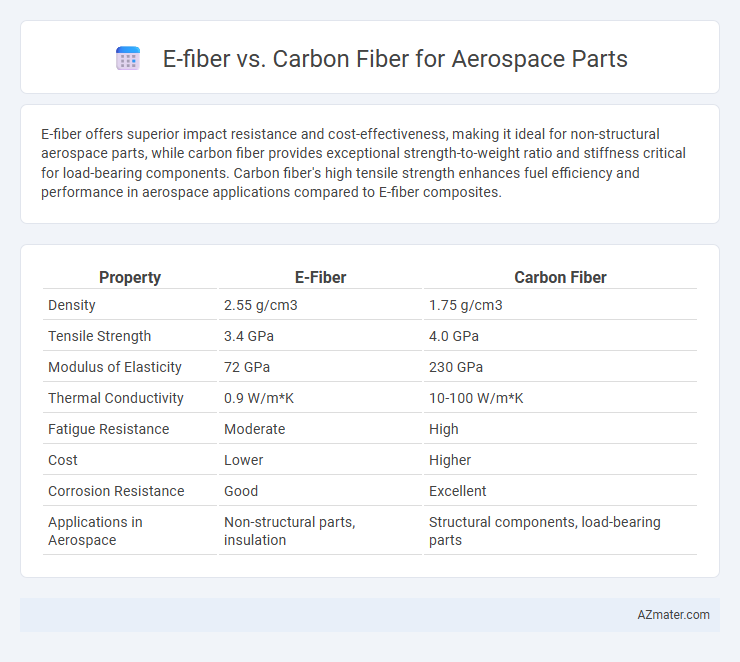E-fiber offers superior impact resistance and cost-effectiveness, making it ideal for non-structural aerospace parts, while carbon fiber provides exceptional strength-to-weight ratio and stiffness critical for load-bearing components. Carbon fiber's high tensile strength enhances fuel efficiency and performance in aerospace applications compared to E-fiber composites.
Table of Comparison
| Property | E-Fiber | Carbon Fiber |
|---|---|---|
| Density | 2.55 g/cm3 | 1.75 g/cm3 |
| Tensile Strength | 3.4 GPa | 4.0 GPa |
| Modulus of Elasticity | 72 GPa | 230 GPa |
| Thermal Conductivity | 0.9 W/m*K | 10-100 W/m*K |
| Fatigue Resistance | Moderate | High |
| Cost | Lower | Higher |
| Corrosion Resistance | Good | Excellent |
| Applications in Aerospace | Non-structural parts, insulation | Structural components, load-bearing parts |
Introduction to Advanced Fibers in Aerospace
E-fibers, composed primarily of alumino-borosilicate glass, offer high tensile strength and excellent electrical insulation, making them suitable for aerospace components requiring lightweight durability and thermal stability. Carbon fibers provide superior stiffness-to-weight ratios and exceptional fatigue resistance, essential for structural aerospace parts subjected to high mechanical stress. Advanced aerospace applications increasingly favor carbon fiber composites for their combination of lightweight performance and enhanced mechanical properties over traditional E-fiber materials.
Overview of E-Fiber and Carbon Fiber Materials
E-fiber, a type of glass fiber reinforced polymer, offers exceptional impact resistance and electrical insulation, making it a cost-effective choice for aerospace components requiring high durability and flexibility. Carbon fiber, composed of tightly woven carbon atoms, provides superior tensile strength and stiffness while maintaining a lightweight profile, essential for structural aerospace parts demanding high performance and weight reduction. Both materials are integral to aerospace engineering, with E-fiber excelling in insulation and energy absorption, whereas carbon fiber dominates in load-bearing and aerodynamic efficiency applications.
Key Properties: E-Fiber vs Carbon Fiber
E-fiber exhibits high tensile strength around 3.5 GPa and excellent electrical insulation, making it ideal for aerospace parts requiring lightweight and non-conductive materials. Carbon fiber offers superior stiffness with a Young's modulus up to 230 GPa and exceptional strength-to-weight ratio, crucial for structural aerospace components demanding maximum load-bearing capacity. Both fibers provide corrosion resistance and fatigue durability, but carbon fiber's thermal stability surpasses E-fiber, favoring high-temperature aerospace applications.
Strength-to-Weight Ratio Comparison
E-fiber composites exhibit a favorable strength-to-weight ratio, making them suitable for moderate aerospace applications where cost efficiency is critical, but they lag behind carbon fiber in tensile strength and stiffness. Carbon fiber offers superior strength-to-weight performance, providing higher tensile strength, stiffness, and fatigue resistance, which significantly enhances aerospace part durability and reduces overall structural weight. This advantage allows carbon fiber to enable the design of lighter, stronger components that improve fuel efficiency and payload capacity in advanced aerospace systems.
Durability and Environmental Resistance
E-fiber exhibits notable durability and superior environmental resistance compared to carbon fiber, particularly excelling in impact absorption and corrosion resistance, making it suitable for aerospace components exposed to harsh conditions. Carbon fiber provides exceptional tensile strength and stiffness, yet it can be vulnerable to moisture-induced degradation and ultraviolet exposure without protective coatings. Selecting E-fiber over carbon fiber enhances long-term performance and maintenance cycles for aerospace parts operating in diverse environmental stress factors.
Manufacturing Processes and Costs
E-fiber offers significant cost advantages over carbon fiber due to its lower raw material expenses and simplified manufacturing processes such as resin transfer molding and compression molding, which reduce labor and cycle times. Carbon fiber provides superior strength-to-weight ratios and thermal resistance, but its production involves energy-intensive processes like high-temperature curing and expensive autoclave treatments, resulting in elevated overall costs. Aerospace parts manufactured with E-fiber typically enable faster production and lower tooling costs, making them ideal for non-structural components, while carbon fiber remains preferred for high-performance structural applications despite higher manufacturing complexity and costs.
Performance in Aerospace Applications
E-fiber exhibits lower density and cost compared to carbon fiber, but carbon fiber surpasses E-fiber with significantly higher tensile strength and stiffness, making it the preferred choice for high-performance aerospace parts. Carbon fiber's superior fatigue resistance and thermal stability enable enhanced durability and weight reduction in critical structural components. The optimal selection depends on balancing performance requirements with manufacturing constraints, where carbon fiber often dominates in weight-sensitive, high-stress aerospace applications.
Safety and Regulatory Considerations
E-fiber offers superior electrical insulation and resistance to corrosion, making it a safer choice for aerospace parts exposed to electromagnetic interference and harsh environments. Carbon fiber provides unmatched strength-to-weight ratio but requires stringent regulatory compliance due to potential flammability and electrical conductivity risks. Aerospace manufacturers must evaluate safety certifications such as FAR Part 25 and FAA guidelines to ensure material selection aligns with aircraft structural integrity and fire safety standards.
Sustainability and Environmental Impact
E-fiber offers a more sustainable alternative to carbon fiber in aerospace parts due to its natural composition and biodegradability, reducing environmental impact throughout the product lifecycle. While carbon fiber provides superior strength-to-weight ratio, its manufacturing process involves high energy consumption and produces non-recyclable waste that challenges sustainability efforts. E-fiber composites enable lower carbon emissions and promote circular economy principles, making them increasingly attractive for eco-conscious aerospace applications.
Future Trends in Aerospace Fiber Materials
E-fiber offers cost-effective advantages and improved sustainability compared to traditional carbon fiber, making it increasingly attractive for aerospace applications aiming to reduce environmental impact. Innovations in hybrid composites combining e-fiber and carbon fiber are enhancing material properties such as strength-to-weight ratio and durability, crucial for next-generation aircraft design. Future trends emphasize scalable manufacturing techniques and recyclable fiber materials to meet stringent aerospace performance and regulatory standards.

Infographic: E-fiber vs Carbon fiber for Aerospace Part
 azmater.com
azmater.com